Response of Methane and Nitrous Oxide Emissions from Peatlands to Permafrost Thawing in Xiaoxing’an Mountains, Northeast China
Abstract
1. Introduction
2. Materials and Methods
2.1. Site Description
2.2. CH4 and N2O Flux Measurements
2.3. Environmental Factors and Plant Biomass
2.4. Data Analysis
3. Results
3.1. Variations of Environmental Factors
3.2. Seasonal Variations of CH4 Fluxes
3.3. Annual and Spatial Variations of CH4 Fluxes
3.4. Seasonal Variations of N2O Fluxes
3.5. Annual and Spatial Variations of N2O fluxes
4. Discussion
4.1. Permafrost Thawing Increased CH4 Fluxes
4.1.1. Effects of Thawing on Seasonal Variations of CH4 Fluxes
4.1.2. Effects of Thawing on Annual Variations of CH4 Fluxes
4.2. No Effects of Permafrost Thawing on N2O Fluxes
5. Conclusions
Author Contributions
Funding
Institutional Review Board Statement
Informed Consent Statement
Data Availability Statement
Acknowledgments
Conflicts of Interest
References
- Zhang, T.; Barry, R.G.; Knowles, K.; Heginbottom, J.A.; Brown, J. Statistics and characteristics of permafrost and ground-ice distribution in the Northern Hemisphere. Polar Geogr. 2008, 31, 47–68. [Google Scholar] [CrossRef]
- Tarnocai, C.; Canadell, J.G.; Schuur, E.A.G.; Kuhry, P.; Mazhitova, G.; Zimov, S. Soil organic carbon pools in the northern circumpolar permafrost region. Glob. Biogeochem. Cycles 2009, 23, GB2023. [Google Scholar] [CrossRef]
- Schuur, E.A.G.; Mcguire, A.D.; Schädel, C.; Grosse, G.; Harden, J.W.; Hayes, D.J.; Hugelius, G.; Koven, C.D.; Kuhry, P.; Lawrence, D.M.; et al. Climate change and the permafrost carbon feedback. Nature 2015, 520, 171–179. [Google Scholar] [CrossRef]
- Lawrence, D.M.; Slater, A.G. A projection of severe near-surface permafrost degradation during the 21st century. Geophys. Res. Lett. 2005, 32, L24401. [Google Scholar] [CrossRef]
- Elberling, B.; Christiansen, H.H.; Hansen, B.U. High nitrous oxide production from thawing permafrost. Nat. Geosci. 2010, 3, 332–335. [Google Scholar] [CrossRef]
- Natali, S.M.; Schuur, E.A.G.; Mauritz, M.; Schade, J.D.; Celis, G.; Grummer, K.G.; Johnston, C.; Krapek, J.; Pegoraro, E.; Salmon, V.G.; et al. Permafrost thaw and soil moisture driving CO2 and CH4 release from upland tundra. J. Geophys. Res. Biogeosci. 2015, 120, 525–537. [Google Scholar] [CrossRef]
- Kohnert, K.; Serafimovich, A.; Metzger, S.; Hartmann, J.X.R.; Sachs, T. Strong geologic methane emissions from discontinuous terrestrial permafrost in the Mackenzie Delta, Canada. Sci. Rep. 2017, 7, 5828. [Google Scholar] [CrossRef] [PubMed]
- Lara, M.J.; Lin, D.H.; Andresen, C.; Lougheed, L.; Tweedie, C.E. Nutrient Release From Permafrost Thaw Enhances CH4 Emissions From Arctic Tundra Wetlands. J. Geophys. Res. Biogeosci. 2019, 124, 1560–1573. [Google Scholar] [CrossRef]
- IPCC 2007. Climate Change 2007: The Physical Science Basis; Cambridge University Press: New York, NY, USA, 2007. [Google Scholar]
- Johansson, T.; Malmer, N.; Crill, P.; Friborg, T.; Åkerman, J.; Mastepanov, M.; Christensen, T.R. Decadal vegetation changes in a northern peatland, greenhouse gas fluxes and net radiative forcing. Glob. Chang. Biol. 2006, 12, 2352–2369. [Google Scholar] [CrossRef]
- Turetsky, M.R.; Wieder, R.K.; Vitt, D.H.; Evans, R.J.; Scott, K.D. The disappearance of relict permafrost in boreal north America: Effects on peatland carbon storage and fluxes. Glob. Chang. Biol. 2007, 13, 1922–1934. [Google Scholar] [CrossRef]
- Segers, R. Methane production and methane consumption-a review of processes underlying wetland methane fluxes. Biogeochemistry 1998, 41, 23–51. [Google Scholar] [CrossRef]
- Richardson, D.; Felgate, H.; Watmough, N.; Thomson, A.; Baggs, E. Mitigating release of the potent greenhouse gas N2O from the nitrogen cycle—Could enzymic regulation hold the key? Trends Biotechnol. 2009, 27, 388–397. [Google Scholar] [CrossRef]
- Åkerman, H.J.; Johansson, M. Thawing permafrost and thicker active layers in sub-arctic Sweden. Permafr. Periglac. Process. 2008, 19, 279–292. [Google Scholar] [CrossRef]
- Kim, Y. Effect of thaw depth on fluxes of CO2 and CH4 in manipulated Arctic coastal tundra of Barrow, Alaska. Sci. Total Environ. 2015, 505, 385–389. [Google Scholar] [CrossRef] [PubMed]
- Romanovsky, V.E.; Sazonova, T.S.; Balobaev, V.T.; Shender, N.I.; Sergueev, D.O. Past and recent changes in air and permafrost temperatures in eastern Siberia. Glob. Planet. Chang. 2007, 56, 399–413. [Google Scholar] [CrossRef]
- Christensen, T.R.; Johansson, T.R.; Åkerman, H.J.; Mastepanov, M.; Malmer, N.; Friborg, T.; Crill, P.; Svensson, B.H. Thawing sub-arctic permafrost: Effects on vegetation and methane emissions. Geophys. Res. Lett. 2004, 31, L04501. [Google Scholar] [CrossRef]
- Bubier, J.L.; Moore, T.R. An ecological perspective on methane emission from northern wetlands. Trends. Ecol. Evol. 1994, 9, 460–464. [Google Scholar] [CrossRef]
- Yan, L.; Zhang, X.; Wu, H.; Kang, E.; Li, Y.; Wang, J.; Yan, Z.; Zhang, K.; Kang, X. Disproportionate changes in the CH4 emissions of six water table levels in an alpine peatland. Atmosphere 2020, 11, 1165. [Google Scholar] [CrossRef]
- Anisimov, O.A.; Reneva, S. Permafrost and changing climate: The Russian perspective. Ambio 2006, 35, 169–175. [Google Scholar] [CrossRef]
- Friborg, T.; Christensen, T.R.; Hansen, B.U.; Nordstroem, C.; Soegaard, H. Trace gas exchange in a high-arctic valley 2: Landscape CH4 fluxes measured and modeled using eddy correlation data. Glob. Biogeochem. Cycles 2000, 14, 715–724. [Google Scholar] [CrossRef]
- van Huissteden, J.; Maximov, T.C.; Dolman, A.J. High methane flux from an arctic floodplain (Indigirka lowlands, eastern Siberia). J. Geophys. Res. 2005, 110, G02002. [Google Scholar] [CrossRef]
- Salmon, V.G.; Soucy, P.; Maurizt, M.; Celis, G.; Natali, S.M.; Mack, M.C.; Schuur, E.A.G. Nitrogen availability increases in a tundra ecosystem during five years of experimental permafrost thaw. Glob. Chang. Biol. 2016, 22, 1927–1941. [Google Scholar] [CrossRef] [PubMed]
- Liu, Y.S.; Zhu, R.B.; Ma, D.W.; Xu, H.; Luo, Y.H.; Huang, T.; Sun, L.G. Temporal and spatial variations of nitrous oxide fluxes from the littoral zones of three alga-rich lakes in coastal Antarctica. Atmos. Environ. 2012, 45, 1464–1475. [Google Scholar] [CrossRef]
- Teepe, R.; Brumme, R.; Beese, F. Nitrous oxide emissions from soil during freezing and thawing periods. Soil. Biol. Biochem. 2001, 33, 1269–1275. [Google Scholar] [CrossRef]
- Voigt, C.; Lamprecht, R.E.; Marushchak, M.E.; Lind, A.; Novakovskiy, A.; Aurela, M.; Martikainen, P.J.; Biasi, C. Warming of subarctic tundra increases emissions of all three important greenhouse gases-carbon dioxide, methane, and nitrous oxide. Glob. Chang. Biol. 2017, 23, 3121–3138. [Google Scholar] [CrossRef] [PubMed]
- Voigt, C.; Marushchak, M.E.; Lamprecht, R.E.; Jackowicz-Korczyńskic, M.; Lindgren, A.; Mastepanov, M.; Granlund, L.; Christensen, T.R.; Tahvanainen, T.; Martikainen, P.J.; et al. Increased nitrous oxide emissions from Arctic peatlands after permafrost thaw. Proc. Natl. Acad. Sci. USA 2017, 114, 6238–6243. [Google Scholar] [CrossRef] [PubMed]
- Payette, S.; Delwaide, A.; Caccianiga, M.; Beauchemin, M. Accelerated thawing of subarctic peatland permafrost over the last 50 years. Geophys. Res. Lett. 2004, 31, L18208. [Google Scholar] [CrossRef]
- Jorgenson, M.T.; Shur, Y.L.; Pullman, E.R. Abrupt increase in permafrost degradation in Arctic Alaska. Geophys. Res. Lett. 2006, 33, L02503. [Google Scholar] [CrossRef]
- Ding, W.X.; Cai, Z.C.; Tsuruta, H.; Li, X.P. Effect of standing water depth on methane emissions from freshwater marshes in northeast China. Atmos. Environ. 2002, 36, 5149–5157. [Google Scholar] [CrossRef]
- Zhu, R.B.; Liu, Y.S.; Ma, J.; Xu, H.; Sun, L. Nitrous oxide flux to the atmosphere from two coastal tundra wetlands in eastern Antarctica. Atmos. Environ. 2008, 42, 2437–2447. [Google Scholar] [CrossRef]
- Pärn, J.; Verhoeven, J.T.A.; Butterbach-Bahl, K.; Dise, N.B.; Ullah, S.; Aasa, A.; Egorov, S.; Espenberg, M.; Järveoja, J.; Jauhiainen, J.; et al. Nitrogen-rich organic soils under warm well-drained conditions are global nitrous oxide emission hotspots. Nat. Commun. 2018, 9, 1135. [Google Scholar] [CrossRef] [PubMed]
- Viru, B.; Veber, G.; Jaagus, J.; Kull, A.; Maddison, M.; Muhel, M.; Espenberg, M.; Teemusk, A.; Mander, Ü. Wintertime Greenhouse Gas Fluxes in Hemiboreal Drained Peatlands. Atmosphere 2020, 11, 731. [Google Scholar] [CrossRef]
- Camill, P.; Chihara, L.; Adams, B.; Andreassi, C.; Barry, A.; Kalim, S.; Limmer, J.; Mandell, M.; Rafert, G. Early life history transitions and recruitment of Picea mariana in thawed boreal permafrost peatlands. Ecology 2010, 91, 448–459. [Google Scholar] [CrossRef]
- Helbig, M.; Pappas, C.; Sonnentag, O. Permafrost thaw and wildfire: Equally important drivers of boreal tree cover changes in the Taiga Plains, Canada. Geophys. Res. Lett. 2016, 43, 1598–1606. [Google Scholar] [CrossRef]
- Jørgenson, C.J.; Struwe, S.; Elberling, B. Temporal trends in N2O flux dynamics in a Danish wetland -effects of plant mediated gas transport of N2O and O2 following changes in water level and soil mineral-N availability. Glob. Chang. Biol. 2012, 18, 210–222. [Google Scholar] [CrossRef]
- Hu, Q.W.; Cai, J.Y.; Yao, B.; Wu, Q.; Wang, Y.Q.; Xu, X.L. Plant-mediated methane and nitrous oxide fluxes from a carex meadow in Poyang Lake during drawdown periods. Plant Soil 2016, 400, 367–380. [Google Scholar] [CrossRef]
- Taylor, M.A.; Celis, G.; Ledman, J.D.; Bracho, R.; Schuur, E.A.G. Methane efflux measured by eddy covariance in Alaskan upland tundra undergoing permafrost degradation. J. Geophys. Res. Biogeosci. 2018, 123, 2695–2710. [Google Scholar] [CrossRef]
- Zhou, Y.W.; Guo, D.X. Principal characteristics of permafrost in China. J. Glaciol. Cryopedol. 1982, 4, 1–19, (In Chinese with English Abstract). [Google Scholar]
- Liu, X.T. Wetlands in Northeast China; Science Press: Beijing, China, 2005. (In Chinese) [Google Scholar]
- Jin, H.; Yu, Q.; Lü, L.; Guo, D.; He, R.; Yu, S.; Sun, G.; Li, Y. Degradation of permafrost in the Xing’anling Mountains, northeastern China. Permafr. Periglac. Process 2007, 18, 245–258. [Google Scholar] [CrossRef]
- Miao, Y.; Song, C.; Sun, L.; Wang, X.; Meng, H.; Mao, R. Growing season methane emission from a boreal peatland in the continuous permafrost zone of Northeast China: Effects of active layer depth and vegetation. Biogeosciences 2012, 9, 4455–4464. [Google Scholar] [CrossRef]
- Miao, Y.Q.; Song, C.C.; Wang, X.W.; Meng, H.N.; Sun, L.; Wang, J.Y. Annual carbon gas emissions from a boreal peatland in continuous permafrost zone, northeast China. CLEAN Soil Air Water 2016, 44, 456–463. [Google Scholar] [CrossRef]
- Cui, Q.; Song, C.C.; Wang, X.W.; Shi, F.X.; Yu, X.Y.; Tan, W.W. Effects of warming on N2O fluxes in a boreal peatland of Permafrost region, Northeast China. Sci. Total Environ. 2018, 616, 427–434. [Google Scholar] [CrossRef]
- Liu, X.; Guo, Y.D.; Hu, H.Q.; Sun, C.K.; Zhao, X.K.; Wei, C.L. Dynamics and controls of CO2 and CH4 emissions in the wetland of a montane permafrost region, northeast China. Atmos. Environ. 2015, 122, 454–462. [Google Scholar] [CrossRef]
- Sun, X.X.; Mu, C.C.; Song, C.C. Seasonal and spatial variations of methane emissions from montane wetlands in Northeast China. Atmos. Environ. 2011, 45, 1809–1816. [Google Scholar] [CrossRef]
- Yu, B.; Stott, P.; Yu, H.X.; Li, X.Y. Methane emissions and production potentials of forest swamp wetlands in the Eastern Great Xing’an Mountains, Northeast China. Environ. Manage. 2013, 52, 1149–1160. [Google Scholar] [CrossRef]
- Lin, Q.H.; Leng, X.T.; Hong, B. Peat δ13C record of climate change in XiaoXingan Ling in the past 5000 years. Earth Environ. 2004, 32, 50–54, (In Chinese with English Abstract). [Google Scholar]
- Song, C.C.; Xu, X.F.; Tian, H.Q.; Wang, Y.Y. Ecosystem–atmosphere exchange of CH4 and N2O and ecosystem respiration in wetlands in the Sanjiang Plain, Northeastern China. Glob. Chang. Biol. 2009, 15, 692–705. [Google Scholar] [CrossRef]
- Ström, L.; Christensen, T.R. Below ground carbon turnover and greenhouse gas exchanges in a sub-arctic wetland. Soil Biol. Biochem. 2007, 39, 1689–1698. [Google Scholar] [CrossRef]
- Wickland, K.P.; Striegl, R.G.; Neff, J.C.; Sachs, T. Effects of permafrost melting on CO2 and CH4 exchange of a poorly drained black spruce lowland. J. Geophys. Res. 2006, 111, G02001. [Google Scholar]
- Liblik, L.; Moore, T.R.; Bubier, J.L.; Robinson, S.D. Methane emissions from wetlands in the zone of discontinuous permafrost: Fort Simpson, NWT, Canada. Glob. Biogeochem. Cycles 1997, 11, 485–494. [Google Scholar] [CrossRef]
- Bubier, J.L.; Moore, T.R.; Bellisario, L.M.; Comer, N.T.; Crill, P.M. Ecological controls on methane emission from a northern peatland complex in the zone of discontinuous permafrost, Manitoba, Canada. Glob. Biogeochem. Cycles 1995, 9, 455–470. [Google Scholar] [CrossRef]
- Dinsmore, K.J.; Skiba, U.M.; Billett, M.F.; Rees, R.M.; Drewer, J. Spatial and temporal variability in CH4 and N2O fluxes from a Scottish ombrotrophic peatland. Soil Biol. Biochem. 2009, 41, 1315–1323. [Google Scholar] [CrossRef]
- Ström, L.; Falk, J.M.; Skov, K.; Jackowicz-Korczynski, M.; Mastepanov, M.; Christensen, T.R.; Lund, M.; Schmidt, N.M. Controls of spatial and temporal variability in CH4 flux in a high arctic fen over three years. Biogeochemistry 2015, 125, 21–35. [Google Scholar] [CrossRef]
- Nakano, T.; Kuniyoshi, S.; Fukuda, M. Temporal variation in methane emission from tundra wetlands in a permafrost area, northeastern Siberia. Atmos. Environ. 2000, 34, 1205–1213. [Google Scholar] [CrossRef]
- Turetsky, M.R.; Wieder, R.K.; Vitt, D.H. Boreal peatland C fluxes under varying permafrost regimes. Soil. Biol. Biochem. 2002, 34, 907–912. [Google Scholar] [CrossRef]
- Mackelprang, R.; Waldrop, M.P.; DeAngelis, K.M.; David, M.M.; Chavarria, K.L.; Blazewicz, S.J.; Rubin, E.M.; Jansson, J.K. Metagenomic analysis of a permafrost microbial community reveals a rapid response to thaw. Nature 2011, 480, 368–371. [Google Scholar] [CrossRef]
- Hultman, J.; Waldrop, M.P.; Mackelprang, R.; David, M.M.; McFarland, J.; Blazewicz, S.J.; Harden, J.; Turetsky, M.R.; McGuire, A.D.; Shah, M.B.; et al. Multi-omics of permafrost, active layer and thermokarst bog soil microbiomes. Nature 2015, 521, 208–212. [Google Scholar] [CrossRef]
- Ström, L.; Ekberg, A.; Mastepanov, M.; Christensen, T.R. The effect of vascular plants on carbon turnover and methane emissions from a tundra wetland. Glob. Chang. Biol. 2003, 9, 1185–1192. [Google Scholar] [CrossRef]
- Koelbener, A.; Ström, L.; Edwards, P.J.; Venterink, H.O. Plant species from mesotrophic wetlands cause relatively high methane emissions from peat soil. Plant Soil 2010, 326, 147–158. [Google Scholar] [CrossRef]
- Sun, X.X.; Song, C.C.; Guo, Y.D.; Wang, X.W.; Yang, G.S.; Li, Y.C.; Mao, R.; Lu, Y.Z. Effect of plants on methane emissions from a temperate marsh in different seasons. Atmos. Environ. 2012, 60, 277–282. [Google Scholar] [CrossRef]
- Huttunen, J.T.; Nykänen, H.; Turunen, J.; Martikainen, P.J. Methane emissions from natural peatlands in the northern boreal zone in Finland, Fennoscandia. Atmos. Environ. 2003, 37, 147–151. [Google Scholar] [CrossRef]
- Treat, C.C.; Bubier, J.L.; Varner, R.K.; Crill, P.M. Timescale dependence of environmental and plant-mediated controls on CH4 flux in a temperate fen. J. Geophys. Res. 2007, 112, G01014. [Google Scholar]
- Moore, T.R.; Young, A.D.; Bubier, J.L.; Humphreys, E.R.; Lafleur, P.M.; Roulet, N.T. A multi-year record of methane flux at the Mer Bleue bog, southern Canada. Ecosystems 2011, 14, 646–657. [Google Scholar] [CrossRef]
- Shigubara, R.; Sugimoto, A.; Murase, J.; Iwahana, G.; Tei, S.; Liang, M.; Takano, S.; Morozumi, T.; Maximov, T.C. Multi-year effect of wetting on CH4 flux at taiga–tundra boundary in northeastern Siberia deduced from stable isotope ratios of CH4. Biogeosciences 2019, 16, 755–768. [Google Scholar] [CrossRef]
- Yang, J.S.; Liu, J.S.; Wang, J.D.; Yu, J.B.; Sun, Z.G.; Li, X.H. Emissions of CH4 and N2O from a wetland in Sangjiang Plain. J. Plant. Ecol. 2006, 30, 432–440, (In Chinese with English Abstract). [Google Scholar]
- Morishita, T.; Matsuura, Y.; Kajimoto, T.; Osawa, A.; Zyryanova, O.A.; Prokushkin, A.S. CH4 and N2O dynamics of a Larix gmelinii forest in a continuous permafrost region of central Siberia during the growing season. Polar Res. 2014, 8, 156–165. [Google Scholar] [CrossRef]
- Yu, J.B.; Liu, J.S.; Wang, J.D.; Sun, W.D.; Patrick, W.H., Jr.; Meixner, F.X. Nitrous oxide emission from Deyeuxia angustifolia freshwater marsh in Northeast China. Environ. Manage. 2007, 40, 613–622. [Google Scholar] [CrossRef]
- Chen, Q.Q.; Zhu, R.B.; Wang, Q.; Xu, H. Methane and nitrous oxide fluxes from four tundra ecotopes in Ny-Ålesund of the High. J. Environ. Sci. 2014, 26, 1403–1410. [Google Scholar] [CrossRef]
- Lohila, A.; Aurela, M.; Hatakka, J.; Pihlatie, M.; Minkkinen, K.; Penttilä, T.; Laurila, T. Responses of N2O fluxes to temperature, water table and N deposition in a northern boreal fen. Eur. J. Soil Sci. 2010, 61, 651–661. [Google Scholar] [CrossRef]
- Wang, J.Y.; Song, C.C.; Zhang, J.; Wang, L.L.; Zhu, X.Y.; Shi, F.X. Temperature sensitivity of soil carbon mineralization and nitrous oxide emission in different ecosystems along a mountain wetland-forest ecotone in the continuous permafrost of Northeast China. Catena 2014, 121, 110–118. [Google Scholar] [CrossRef]
- Rodionow, A.; Flessa, H.; Kazansky, O.; Guggenberger, G. Organic matter composition and potential trace gas production of permafrost soils in the forest tundra in northern Siberia. Geoderma 2006, 135, 49–62. [Google Scholar] [CrossRef]
- Waldrop, M.P.; Mcfarland, J.; Euskirchen, E.S.; Turetsky, M.R.; Harden, J.W.; Manies, K.; Jones, M.; McGuire, A.D. Carbon balance and greenhouse gas fluxes in a thermokarst bog in interior Alaska: Positive and negative feedbacks from permafrost thaw. In AGU Fall Meeting Abstracts; AGU: Washington, DC, USA, 2012; p. B14D-03. [Google Scholar]
- Yang, G.; Peng, Y.; Marushchak, M.E.; Chen, Y.; Wang, G.; Li, F.; Zhang, D.; Wang, J.; Yu, J.; Liu, L.; et al. Magnitude and pathways of increased nitrous oxide emissions from uplands following permafrost thaw. Environ. Sci. Technol. 2018, 52, 9162–9169. [Google Scholar] [CrossRef] [PubMed]
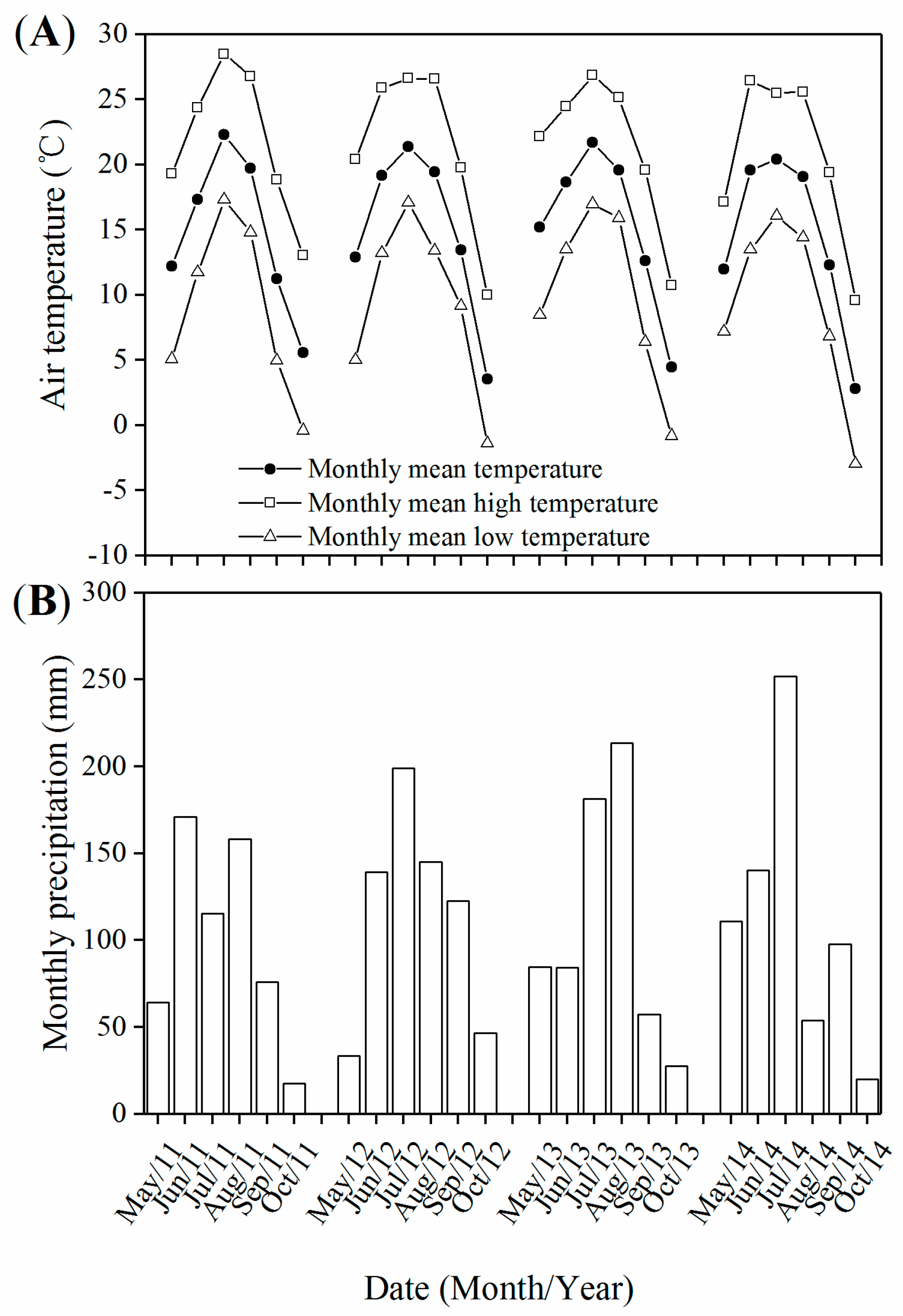
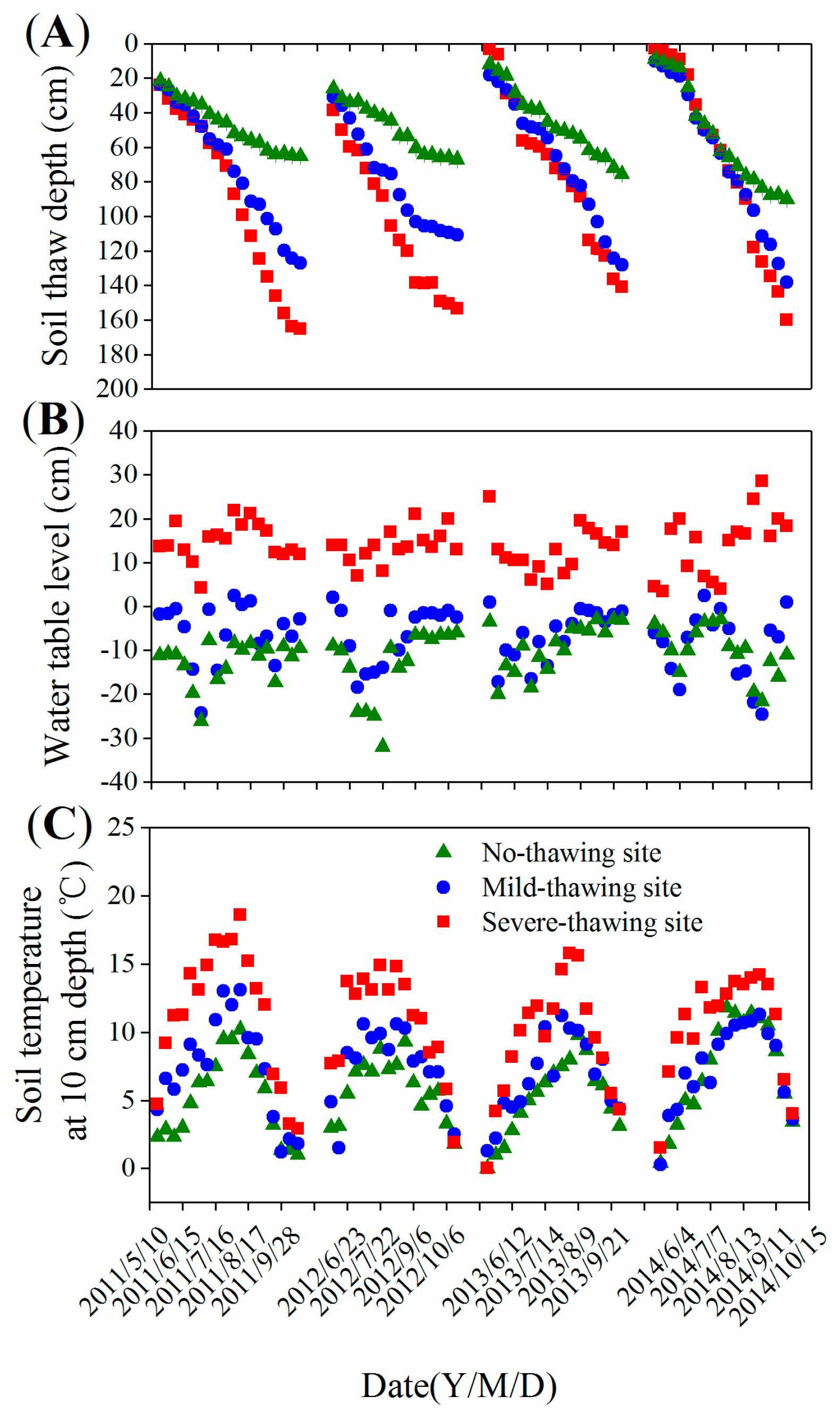
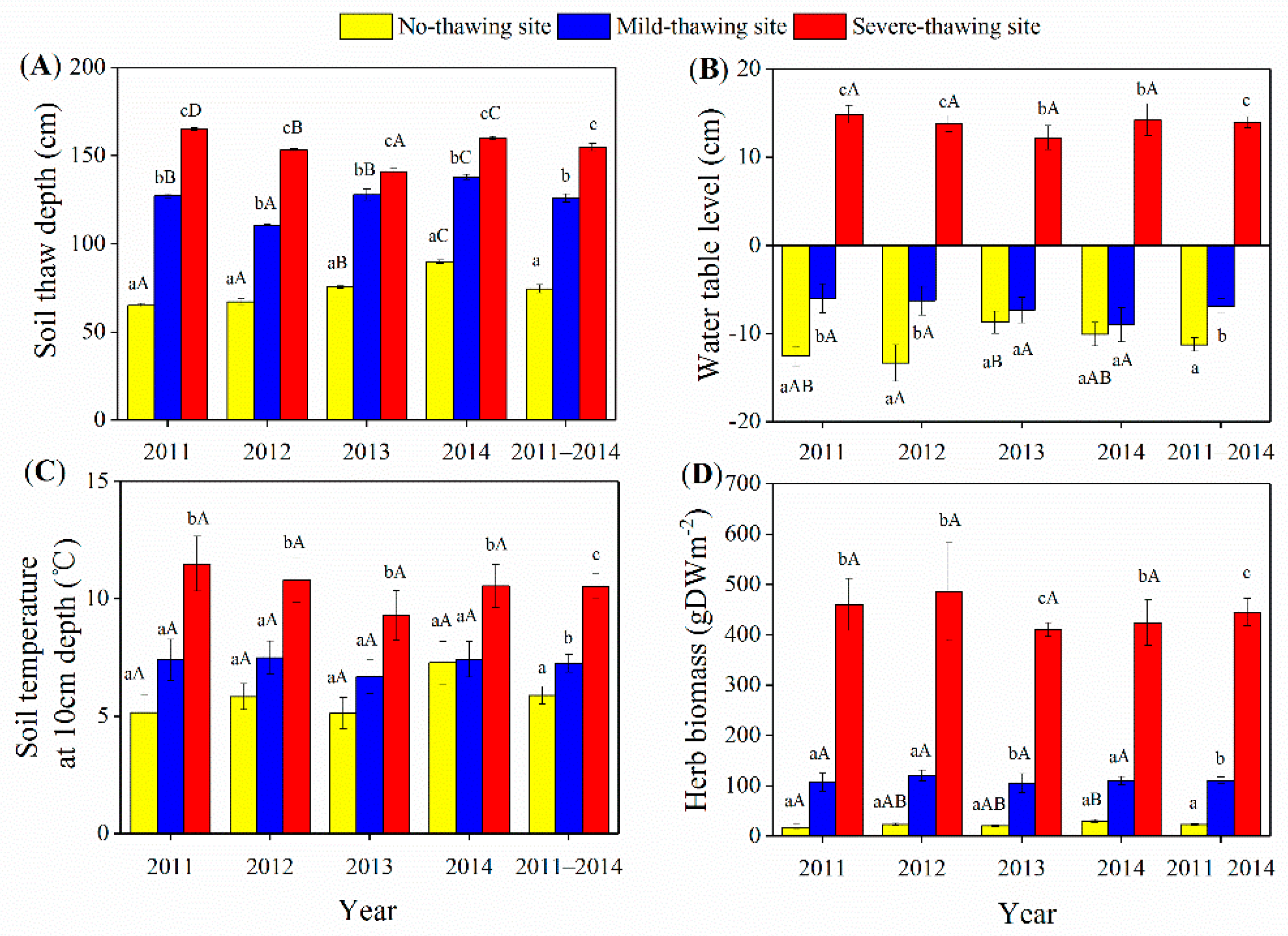
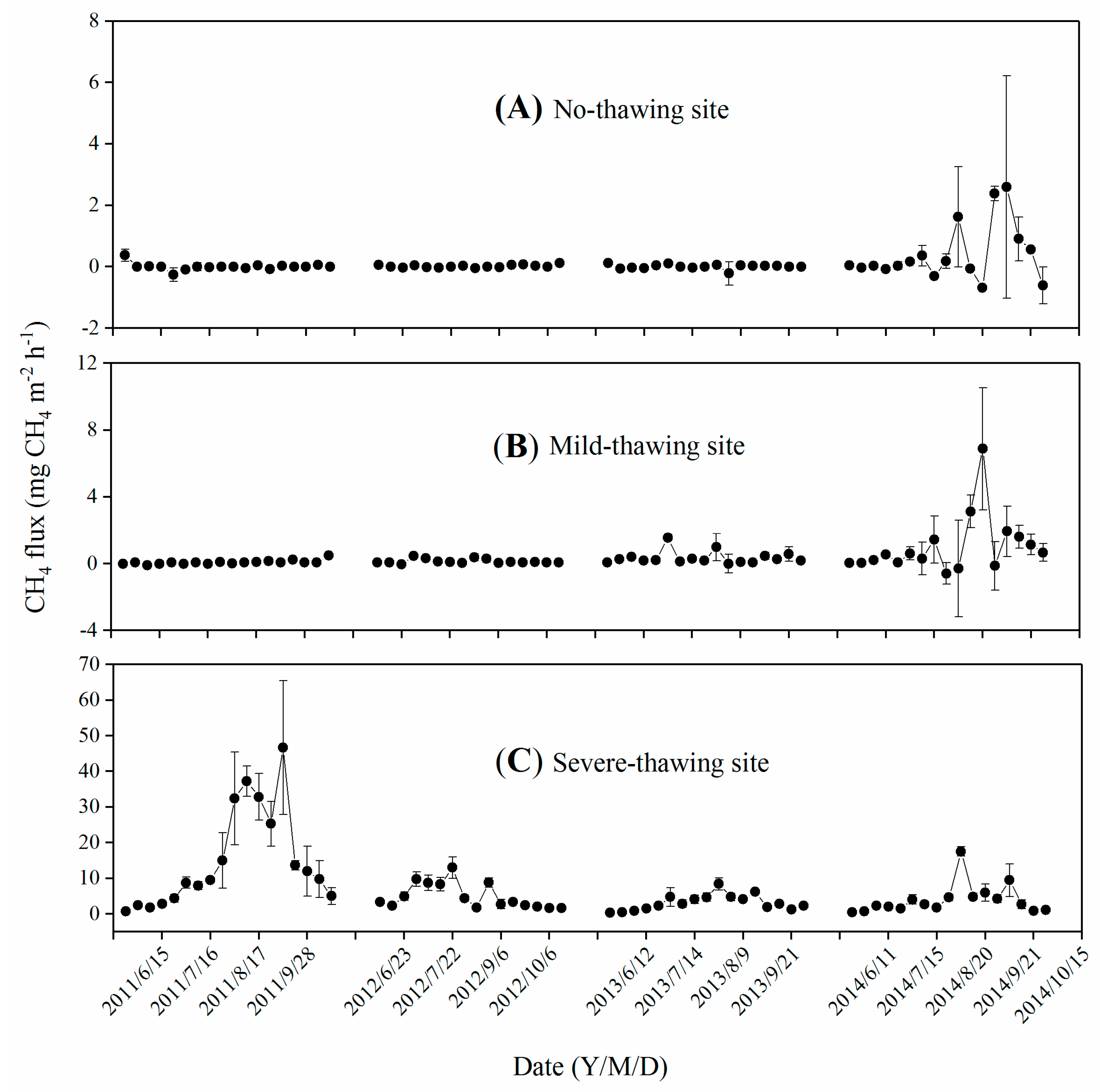
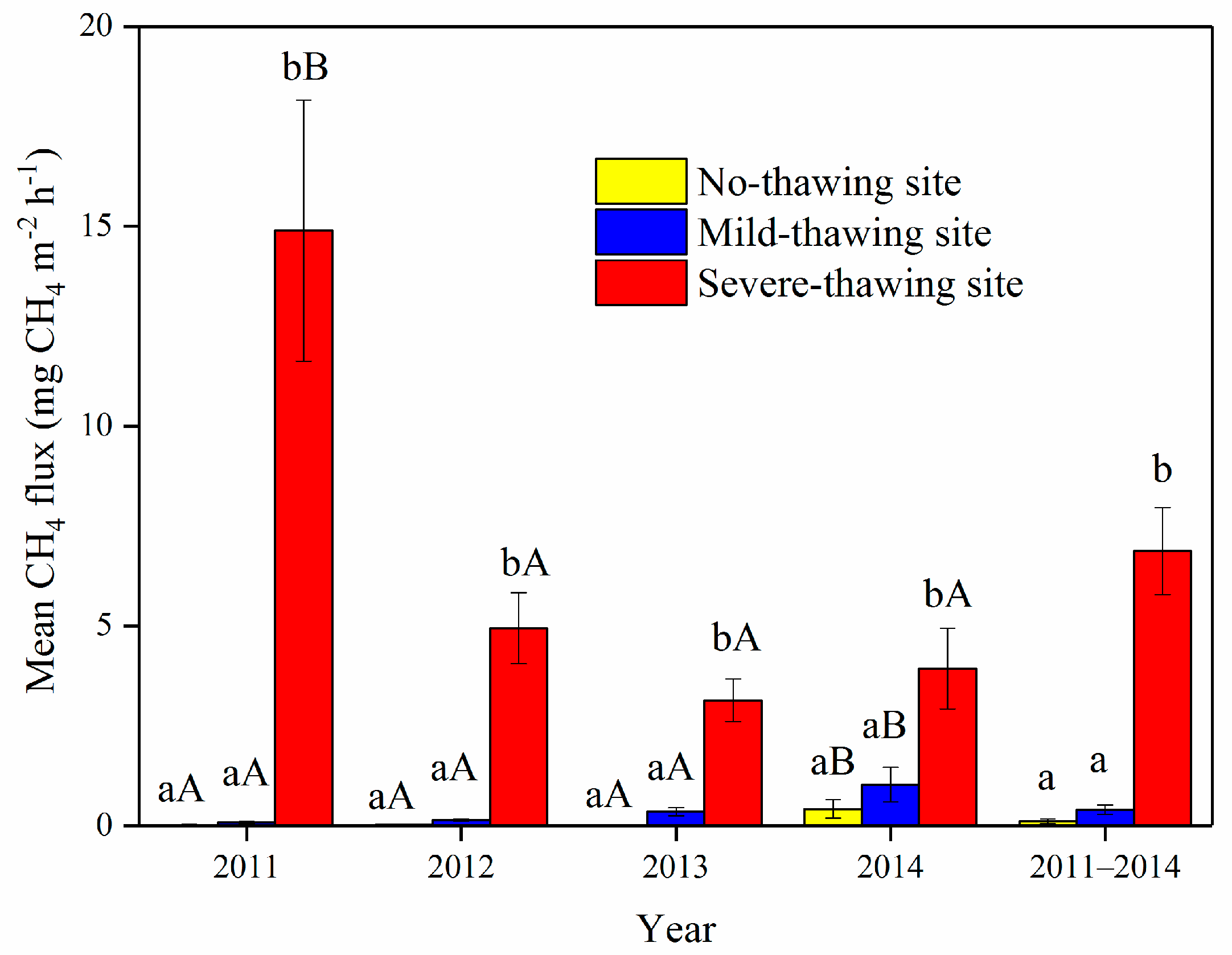
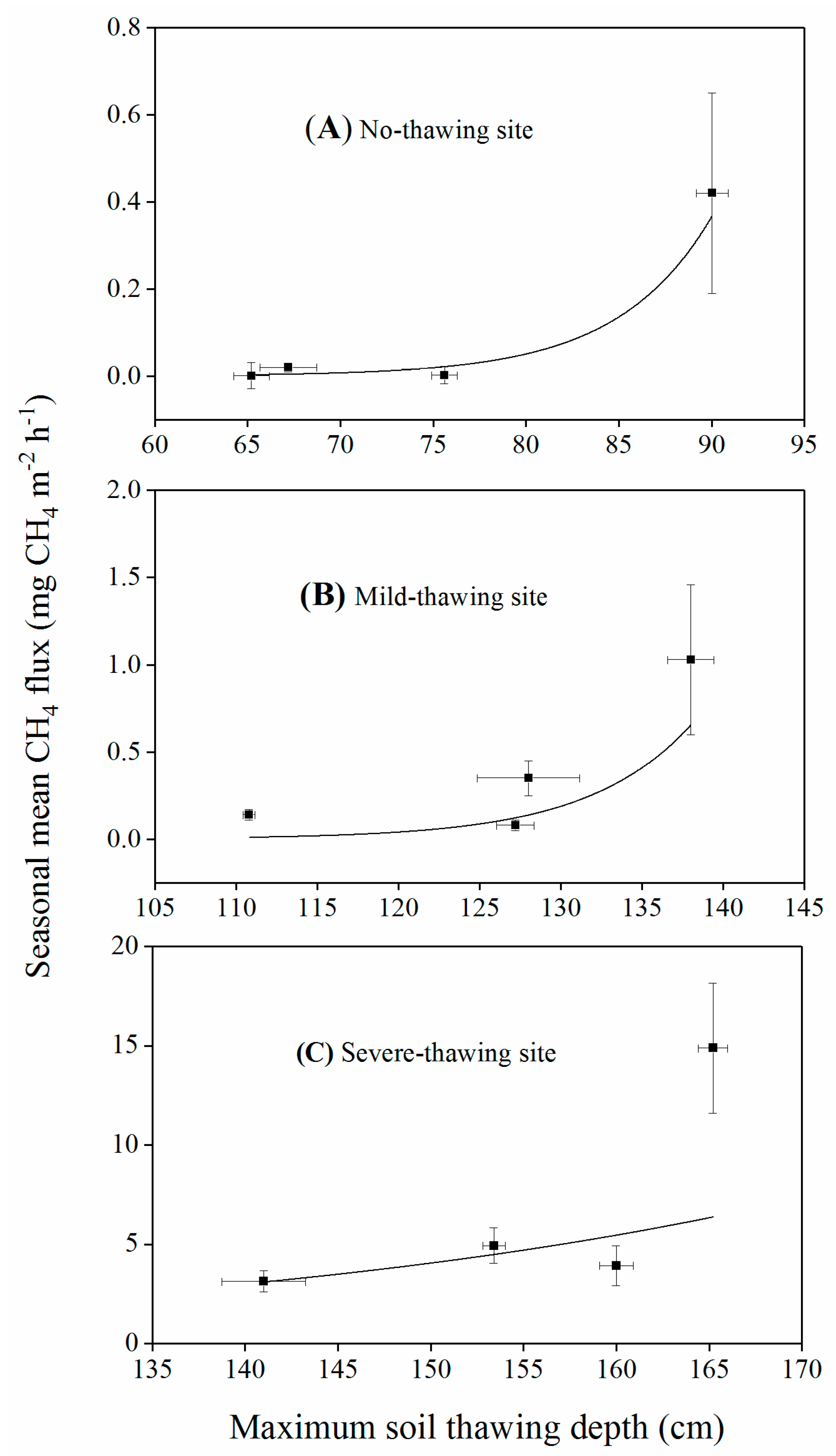
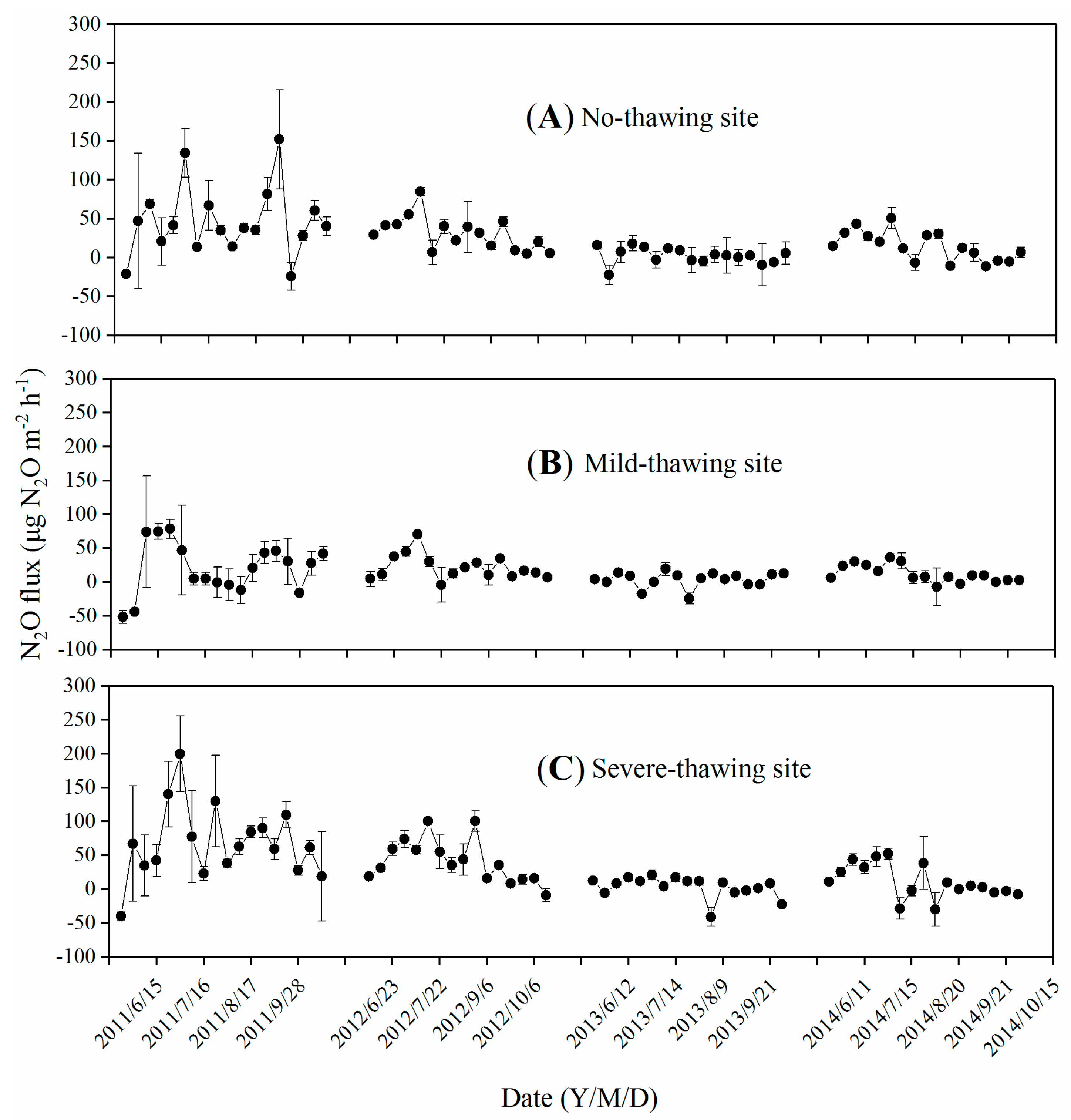
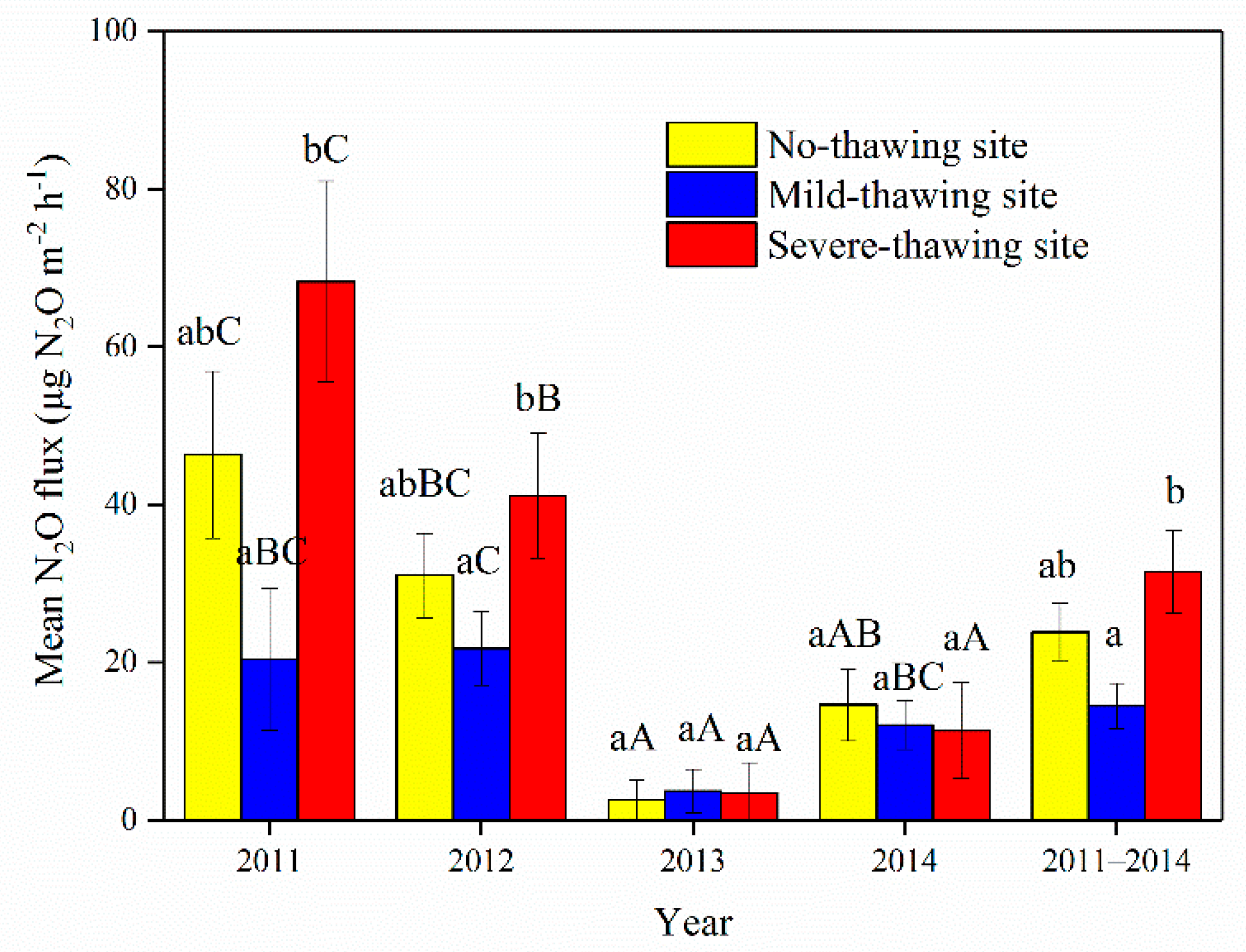
| Soil Characteristics | No-Thawing Site | Mild-Thawing Site | Severe-Thawing Site | |||
|---|---|---|---|---|---|---|
| 0–20 cm | 20–40 cm | 0–20 cm | 20–40 cm | 0–20 cm | 20–40 cm | |
| pH | 4.75 ± 0.05 | 4.89 ± 0.02 | 4.72 ± 0.02 | 5.00 ± 0.06 | 4.74 ± 0.13 | 4.79 ± 0.15 |
| SOC/gkg−1 | 238.91 ± 3.57 | 290.96 ± 64.76 | 213.15 ± 15.62 | 192.92 ± 12.85 | 182.61 ± 3.89 | 168.49 ± 4.04 |
| TN/gkg−1 | 13.33 ± 0.41 | 13.28 ± 0.42 | 13.37 ± 0.04 | 13.66 ± 0.34 | 12.48 ± 1.40 | 12.18 ± 0.26 |
| C/N | 17.92 | 21.91 | 15.94 | 14.12 | 14.63 | 13.83 |
| Site | Equation | Variable | df | R2 | p |
|---|---|---|---|---|---|
| No-thawing site | Fs = −0.173 + 0.048T | Soil temperature | 67 | 0.074 | <0.05 |
| Fs = 0.237 + 0.007TD | Thaw depth | 67 | 0.083 | <0.05 | |
| Severe thawing site | Fs = 0.82 × 100.159T | Soil temperature | 67 | 0.407 | <0.01 |
| Fs = −3.172 + 0.26TD − 0.001TD2 | Thaw depth | 67 | 0.142 | <0.01 |
| Site | Equation | Variable | df | R2 | p |
|---|---|---|---|---|---|
| No-thawing site | Fs = 10.087 − 1.227x | Water table | 67 | 0.058 | <0.05 |
| Severe thawing site | Fs = −4.682 + 3.430x | Soil temperature | 67 | 0.098 | <0.05 |
Publisher’s Note: MDPI stays neutral with regard to jurisdictional claims in published maps and institutional affiliations. |
© 2021 by the authors. Licensee MDPI, Basel, Switzerland. This article is an open access article distributed under the terms and conditions of the Creative Commons Attribution (CC BY) license (http://creativecommons.org/licenses/by/4.0/).
Share and Cite
Sun, X.; Wang, H.; Song, C.; Jin, X.; Richardson, C.J.; Cai, T. Response of Methane and Nitrous Oxide Emissions from Peatlands to Permafrost Thawing in Xiaoxing’an Mountains, Northeast China. Atmosphere 2021, 12, 222. https://doi.org/10.3390/atmos12020222
Sun X, Wang H, Song C, Jin X, Richardson CJ, Cai T. Response of Methane and Nitrous Oxide Emissions from Peatlands to Permafrost Thawing in Xiaoxing’an Mountains, Northeast China. Atmosphere. 2021; 12(2):222. https://doi.org/10.3390/atmos12020222
Chicago/Turabian StyleSun, Xiaoxin, Hongjun Wang, Changchun Song, Xin Jin, Curtis J. Richardson, and Tijiu Cai. 2021. "Response of Methane and Nitrous Oxide Emissions from Peatlands to Permafrost Thawing in Xiaoxing’an Mountains, Northeast China" Atmosphere 12, no. 2: 222. https://doi.org/10.3390/atmos12020222
APA StyleSun, X., Wang, H., Song, C., Jin, X., Richardson, C. J., & Cai, T. (2021). Response of Methane and Nitrous Oxide Emissions from Peatlands to Permafrost Thawing in Xiaoxing’an Mountains, Northeast China. Atmosphere, 12(2), 222. https://doi.org/10.3390/atmos12020222







